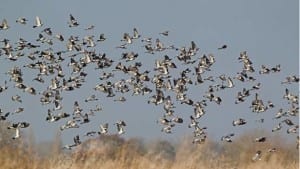 Birds don’t seem all that smart. Despite being expert in the air, flying better than anything humanity has ever constructed, they still collide with a stunning number of cars and planes. Past studies have even revealed that a whopping 340 million birds have fatal run-ins with windshields annually. And yet, pigeons seem to never hit a single telephone pole, cable, flag posts, or anything else a cityscape can throw at them. How can this be? A new study of mid-flight behavior has the answer.
Birds don’t seem all that smart. Despite being expert in the air, flying better than anything humanity has ever constructed, they still collide with a stunning number of cars and planes. Past studies have even revealed that a whopping 340 million birds have fatal run-ins with windshields annually. And yet, pigeons seem to never hit a single telephone pole, cable, flag posts, or anything else a cityscape can throw at them. How can this be? A new study of mid-flight behavior has the answer.
A lot of research has gone into selling the idea that birds aren’t as dumb as we think they are. They can count, think rationally, and even understand speech sound mechanics. And did we mention that they fly better than anything humans ever constructed? So why is it that birds keep smacking right into our cars and planes? You’d think they’d of learned their lesson by now. Unfortunately, according to experts, that just won’t happen.
Why Agile Birds Still Hit Cars and Planes
As nocturnal animals, bats have special neurons in their brains that enable safe flight, according to a new study.
Neurons in Bat Brains Enable Safe Flight
Published in the Proceeding of the US National Academy of Science (PNAS), a new study details how pigeons instinctively know when to switch between safe or efficient flight.
What do I mean by that? Researchers David Williams and Andre Biewener, at Harvard University, were able to get some exceptional footage of pigeons dodging random obstacles after they trained four of urban life’s infamous flying rats to fly back and forth across a flight corridor. After the pigeons made this trek an everyday thing, the researcher introduced obstacles into their paths.
What they found was that pigeons take one of two approaches to avoid slamming their delicate wings into tight spaces.
They can choose the safest approach, which is to fold their wings completely against their bodies – temporarily losing altitude in the process; or they could chose to do a so-called “wing pause” where they simply don’t lower their wings from over their head mid-flight. This second approach is also more energy efficient, as it allows the pigeon to immediately resume flapping once the obstacle is cleared.
It was thought that perhaps which way the birds chose was simply be based on the timing of their flaps, but after running several experiments with wider or smaller gaps between or around obstacles, Williams and Biewener found that pigeons are actually actively making the decision.
“The choice between these two postures seems mediated by an element of caution or uncertainly,” they wrote in the study. “The efficient flight strategy (wing pause) is chosen where gaps are wider and there is less chance of a collision occurring.”
Otherwise, when there is too much risk of breaking a wing, the pigeons seem to be willing to take extra effort, explaining why few-to-no collisions are ever seen.
About Pigeon Patrol:
Pigeon Patrol Products & Services is the leading manufacturer and distributor of bird deterrent (control) products in Canada. Pigeon Patrol products have solved pest bird problems in industrial, commercial, and residential settings since 2000, by using safe and humane bird deterrents with only bird and animal friendly solutions. At Pigeon Patrol, we manufacture and offer a variety of bird deterrents, ranging from Ultra-flex Bird Spikes with UV protection, Bird Netting, 4-S Gel and the best Ultrasonic and audible sound devices on the market today.
Voted Best Canadian wholesaler for Bird Deterrent products four years in a row.
Contact Info: 1- 877– 4– NO-BIRD (www.pigeonpatrol.ca)

